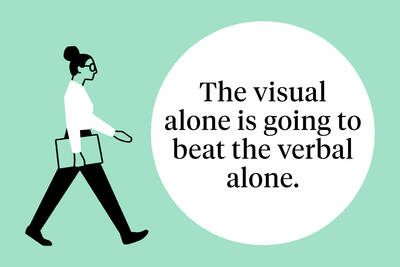Marketing Apr 8, 2020
Four Steps Marketers Can Take to Navigate the Pandemic
Step one: Press pause. Step two: Rethink everything.
It’s hard to imagine a more challenging environment for marketers than the current moment. With a global pandemic affecting the way nearly everyone in the world works and lives, nothing feels certain anymore. And even the uncertainties are shifting rapidly.
“It’s a really complicated time for brands right now, because the world is changing so quickly,” says Tim Calkins, a clinical professor of marketing at Kellogg. “It’s really rare in life that you see things change so fundamentally and profoundly as they’ve changed in the past few weeks.”
So how should brands think about marketing, as markets are upended around them?
Calkins offers four steps companies can take to find a way forward, whether that means delivering the right message at the right time or deciding to say nothing at all.
Step 1: Press Pause
“A lot of people are complaining that they are seeing things from companies that don’t fit the moment: coupons in the Sunday paper that don’t make any sense anymore,” says Calkins.
This is likely a result of marketing efforts getting planned and locked in weeks, even months, in advance.
“The awkward thing is that it’s going to take a while for all that activity to work through,” he says. “And if you’re a marketing leader, one of the first things you want to do is pause everything that you can.”
This is easier said than done, however. These days many campaigns are automated, run by algorithms without a lot of human direction. This can make it challenging to even know which campaigns are even running. So before you can press pause, Calkins advises, you need to figure out everything you’re doing across every channel.
Learn more from Tim Calkins in Kellogg Executive Education’s Kellogg on Branding and Strategic Marketing Communications programs.
Step 2: Rethink Your Plan for Spending and Investment.
This is a big one.
While some companies are dealing with an unexpected wave of demand, most are crippled with the opposite problem: business has dried up, and it’s dried up quickly.
These brands have a critical decision to make: Do they want to invest in their business and marketing efforts in order to stimulate demand? Or do they want to conserve their resources until the environment is more favorable? While some restaurants are going all-in on increasing their takeout capabilities, for instance, many are opting to save their money in the hopes of reopening later.
“Even if you had a lot of money to spend on advertising, people are not feeling inspired to go spend a lot of money.”
— Tim Calkins
But even businesses outside of the hospitality industry are deciding that additional marketing efforts might be misplaced.
“I think there’s no question we’re going to see cuts in advertising, because right now there’s not a lot of money to spend on marketing efforts,” says Calkins. “But the bigger problem is, even if you had a lot of money to spend on advertising, people are not feeling inspired to go spend a lot of money.”
A brand can launch the most fabulous social-media campaign in the world. But if its customers are anxious about paying the rent, it’s not going to matter. “Likewise, if they can’t even leave the house, they’re not going to take advantage of that wonderful sale going on. You’ll say, ‘I don’t need a winter coat right now—I’ll get by,’” says Calkins.
Marketers should now be thinking instead about what their market will look like when the public-health emergency begins to subside.
“It’s not that you get through the pandemic and then everybody goes right back to doing what they were doing,” says Calkins. “People are still going to be staying home. They’ll be very cautious in their spending. As a brand leader, you’ve got to think about how—even after we get through this and things begin to ease up—we are going to begin restarting our business.”
He believes that for many brands, the best decision might be to cut back on current spending and investment altogether, so that money will be available later.
Step 3: Check Your Messaging
For brands that do want to move forward with a campaign in the current environment, they need to ask whether their current message is still relevant and appropriate.
“This challenge is almost a harder one than shutting down your campaigns,” says Calkins. “How do you get the message right, and how do you hit the right tone?”
Campaigns that brands put together just a few weeks ago may no longer be effective, or worse, may register as tone-deaf or insensitive to the difficulties many people are now experiencing.
Some ads are clearly a bad idea. “It’s not a time to be too flippant. It’s not a time to make health jokes. It’s not a time to run ads featuring people hugging each other or ads with big group gatherings,” says Calkins. “Those are pretty easy.”
Determining which ads might work is far harder. “Clearly you need a more serious tone—that’s a given. But at the same time, you don’t want to be too down in the dumps,” he says. “People are looking for a boost. They’re looking for ways to feel okay as we navigate through all of this.”
Some brands have been able to navigate this new environment successfully. Calkins points to Sam’s Club, which recently launched a new ad on primetime television, a rarity for them. “It was really a thank you to all of their employees who are working so hard to try to keep the shelves stocked at this time. And they went through and they named employees all around the country who are working hard,” he says.
This ad works on at least three levels: It gives a nod to Sam’s Club’s employees—“an important group to think about,” Calkins says. It also helps to build the brand, making people feel positively about the organization. And finally, it communicates a business message. “It says: ‘We’re open. We’re ready for business. We’re here to help. We’re a place you can turn to,’” says Calkins.
Calkins points to other brands that have gotten their tone right. A new spot by Jack Daniels taps into how people are trying to connect with each other virtually. Nike launched a campaign about playing in your own home. And a new ad from Budweiser salutes the doctors, nurses, Red Cross workers, and scientists on the front lines fighting the coronavirus.
“You’re seeing the brands that can move quickly to adjust their messages,” says Calkins.
But the key is to move quickly.
“I think these messages will start to seem very predictable and lose their impact if you wait. A month in, people are going to be sick of staying inside. The easy jokes won’t be easy anymore. And we’re going to have a lot more people dying, and more economic hardships, and the uncertainty of when we come out the other side,” he says.
“This is going to get darker before it gets lighter. That’s why the easiest thing to do right now is to pull back on all marketing. And it’s not necessarily a bad idea: better to do nothing than to come across as insensitive or inappropriate.”
Step 4: Look to the Future
Ultimately, brands need to make sure that whatever messaging they engage in, it is consistent with who they are and what their brand stands for.
“Brand purpose has become a big deal,” says Calkins. “Brands say, ‘We care so much about this cause or this particular belief.’ This is a time where you want to be very careful that you live up to that.” If, for example, your brand is built around its low environmental footprint, this is not the time to be sending vast quantities of excess inventory to the landfill or to be swapping in less expensive—but more environmentally damaging—materials.
“You want to make sure those values come across as you make decisions. It’s easy to live up to your values when times are good; it’s a lot harder when times are tough. And now times are tough,” he says.
Companies also need to make sure that whatever message they communicate they can actually deliver on in the future. With so much changing so quickly, and economic predictions looking more and more dire, this becomes incredibly challenging to do.
For instance, while companies might wish to broadcast to the world that they care about their employees, that messaging has to be consistent with how they are acting. “It’s very hard to go out with a message saying, ‘We really care so much about our employees’ at the same time that you’re letting them all go,” says Calkins.
Which brings up another thorny challenge for brands as they look into the future: making sure that their messaging remains sensitive, so that even if they do have to lose some employees, they will be ready to recruit these individuals back to the team. “That’s going to be tough,” he says.
“A lot of a marketer’s job right now is internal messaging. What works in your favor right now is recognizing that we’re all going through this. People understand that times have changed.”



